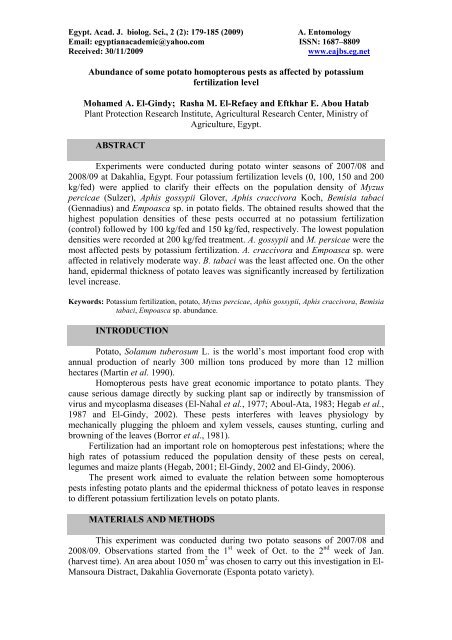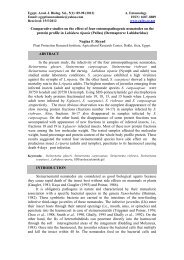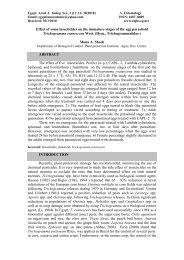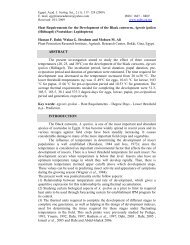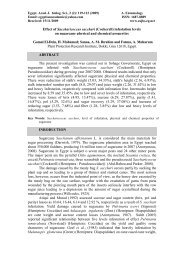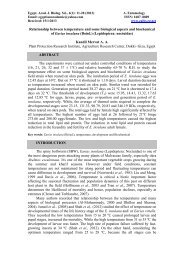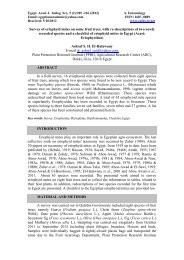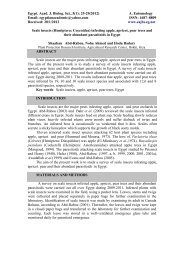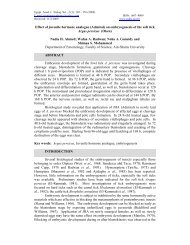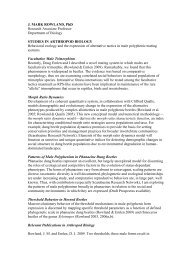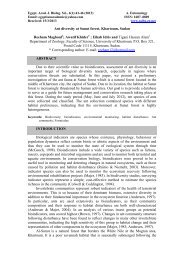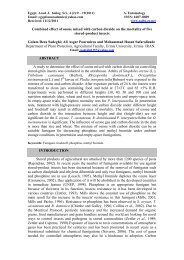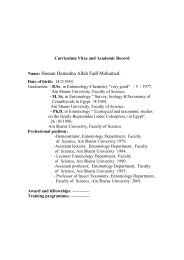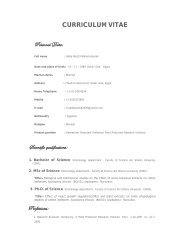Abundance of some potato homopterous pests as affected by ...
Abundance of some potato homopterous pests as affected by ...
Abundance of some potato homopterous pests as affected by ...
You also want an ePaper? Increase the reach of your titles
YUMPU automatically turns print PDFs into web optimized ePapers that Google loves.
Egypt. Acad. J. biolog. Sci., 2 (2): 179-185 (2009) A. Entomology<br />
Email: egyptianacademic@yahoo.com ISSN: 1687–8809<br />
Received: 30/11/2009 www.eajbs.eg.net<br />
<strong>Abundance</strong> <strong>of</strong> <strong>some</strong> <strong>potato</strong> <strong>homopterous</strong> <strong>pests</strong> <strong>as</strong> <strong>affected</strong> <strong>by</strong> pot<strong>as</strong>sium<br />
fertilization level<br />
Mohamed A. El-Gindy; R<strong>as</strong>ha M. El-Refaey and Eftkhar E. Abou Hatab<br />
Plant Protection Research Institute, Agricultural Research Center, Ministry <strong>of</strong><br />
Agriculture, Egypt.<br />
ABSTRACT<br />
Experiments were conducted during <strong>potato</strong> winter se<strong>as</strong>ons <strong>of</strong> 2007/08 and<br />
2008/09 at Dakahlia, Egypt. Four pot<strong>as</strong>sium fertilization levels (0, 100, 150 and 200<br />
kg/fed) were applied to clarify their effects on the population density <strong>of</strong> Myzus<br />
percicae (Sulzer), Aphis gossypii Glover, Aphis craccivora Koch, Bemisia tabaci<br />
(Gennadius) and Empo<strong>as</strong>ca sp. in <strong>potato</strong> fields. The obtained results showed that the<br />
highest population densities <strong>of</strong> these <strong>pests</strong> occurred at no pot<strong>as</strong>sium fertilization<br />
(control) followed <strong>by</strong> 100 kg/fed and 150 kg/fed, respectively. The lowest population<br />
densities were recorded at 200 kg/fed treatment. A. gossypii and M. persicae were the<br />
most <strong>affected</strong> <strong>pests</strong> <strong>by</strong> pot<strong>as</strong>sium fertilization. A. craccivora and Empo<strong>as</strong>ca sp. were<br />
<strong>affected</strong> in relatively moderate way. B. tabaci w<strong>as</strong> the le<strong>as</strong>t <strong>affected</strong> one. On the other<br />
hand, epidermal thickness <strong>of</strong> <strong>potato</strong> leaves w<strong>as</strong> significantly incre<strong>as</strong>ed <strong>by</strong> fertilization<br />
level incre<strong>as</strong>e.<br />
Keywords: Pot<strong>as</strong>sium fertilization, <strong>potato</strong>, Myzus percicae, Aphis gossypii, Aphis craccivora, Bemisia<br />
tabaci, Empo<strong>as</strong>ca sp. abundance.<br />
INTRODUCTION<br />
Potato, Solanum tuberosum L. is the world’s most important food crop with<br />
annual production <strong>of</strong> nearly 300 million tons produced <strong>by</strong> more than 12 million<br />
hectares (Martin et al. 1990).<br />
Homopterous <strong>pests</strong> have great economic importance to <strong>potato</strong> plants. They<br />
cause serious damage directly <strong>by</strong> sucking plant sap or indirectly <strong>by</strong> transmission <strong>of</strong><br />
virus and mycopl<strong>as</strong>ma dise<strong>as</strong>es (El-Nahal et al., 1977; Aboul-Ata, 1983; Hegab et al.,<br />
1987 and El-Gindy, 2002). These <strong>pests</strong> interferes with leaves physiology <strong>by</strong><br />
mechanically plugging the phloem and xylem vessels, causes stunting, curling and<br />
browning <strong>of</strong> the leaves (Borror et al., 1981).<br />
Fertilization had an important role on <strong>homopterous</strong> pest infestations; where the<br />
high rates <strong>of</strong> pot<strong>as</strong>sium reduced the population density <strong>of</strong> these <strong>pests</strong> on cereal,<br />
legumes and maize plants (Hegab, 2001; El-Gindy, 2002 and El-Gindy, 2006).<br />
The present work aimed to evaluate the relation between <strong>some</strong> <strong>homopterous</strong><br />
<strong>pests</strong> infesting <strong>potato</strong> plants and the epidermal thickness <strong>of</strong> <strong>potato</strong> leaves in response<br />
to different pot<strong>as</strong>sium fertilization levels on <strong>potato</strong> plants.<br />
MATERIALS AND METHODS<br />
This experiment w<strong>as</strong> conducted during two <strong>potato</strong> se<strong>as</strong>ons <strong>of</strong> 2007/08 and<br />
2008/09. Observations started from the 1 st week <strong>of</strong> Oct. to the 2 nd week <strong>of</strong> Jan.<br />
(harvest time). An area about 1050 m 2 w<strong>as</strong> chosen to carry out this investigation in El-<br />
Mansoura Distract, Dakahlia Governorate (Esponta <strong>potato</strong> variety).
180<br />
Mohamed A. El-Gindy et al.<br />
The area w<strong>as</strong> divided into 12 plots, arranged <strong>as</strong> completely randomized design.<br />
Nine plots were fertilized with levels <strong>of</strong> fertilization <strong>as</strong> 100, 150 and 200 kg/fed (3<br />
plots/ level <strong>as</strong> replicates) and three plots were no fertilized (<strong>as</strong> control). Pot<strong>as</strong>sium<br />
fertilization (<strong>as</strong> pot<strong>as</strong>sium sulphate 48% K2O) w<strong>as</strong> added after five weeks early in the<br />
growing se<strong>as</strong>on.<br />
Weekly samples <strong>of</strong> 10 leaves/ plot were picked at random from the three levels<br />
<strong>of</strong> the plants (low, mid and upper). Each sample w<strong>as</strong> kept in tight closed paper bag<br />
and transferred to the laboratory in the same day for inspection <strong>by</strong> the bionocular<br />
microscope. The <strong>homopterous</strong> pest, Myzus percicae (Sulzer), Aphis gossypii Glover,<br />
Aphis craccivora Koch, Bemisia tabaci (Gennadius) and Empo<strong>as</strong>ca sp. were counted<br />
and recorded. All plots received normal agricultural practices and were kept free <strong>of</strong><br />
any insecticide treatment.<br />
* Effect <strong>of</strong> fertilization on the thickness <strong>of</strong> <strong>potato</strong> epidermal cells:<br />
Samples <strong>of</strong> <strong>potato</strong> leaves were collected and cleaned up with tap water, cut<br />
into suitable parts, fixed in formalin, acetic acid, alcohol (F.A.A.) solution for at le<strong>as</strong>t<br />
36 hours, dehydrated with n-butyl alcohol, infiltrated and embedded in pure paraffin<br />
wax (M.P.56 – 58 o C) (Johancen, 1940). Sectioning at thickness <strong>of</strong> 14 micron w<strong>as</strong><br />
performed <strong>by</strong> using a rotatory microtome. Paraffin ribbons were mounted on thin<br />
slides and stained with safranin and light green. Stained sections were mounted in<br />
Canada balsam then examined microscopically. The epidermal cell thickness w<strong>as</strong><br />
me<strong>as</strong>ured <strong>by</strong> ocular micrometer.<br />
Data were subjected to correlation and simple regression using Costat (1990)<br />
s<strong>of</strong>t ware.<br />
RESULTS<br />
The effect <strong>of</strong> four levels <strong>of</strong> pot<strong>as</strong>sium fertilization (0, 100, 150 and 200<br />
kg/feddan) on the population density <strong>of</strong> M. percicae, A. gossypii, A. craccivora, B.<br />
tabaci and Empo<strong>as</strong>ca sp. infesting <strong>potato</strong> plants were studied during the two<br />
successive se<strong>as</strong>ons <strong>of</strong> 2007/08 and 2008/09.<br />
Obtained data illustrated in Figures (1 and 2) showed that the highest<br />
population densities <strong>of</strong> these <strong>pests</strong> occurred without any pot<strong>as</strong>sium fertilization<br />
(control) followed <strong>by</strong> using <strong>of</strong> 100 and 150 kg/fed, respectively. Lowest population<br />
densities were recorded when 200 kg/fed were used.<br />
A. gossypii and M. persicae were the most <strong>affected</strong> <strong>pests</strong> <strong>by</strong> pot<strong>as</strong>sium<br />
fertilization, where the correlation coefficient values between their populations and<br />
pot<strong>as</strong>sium fertilization were negative and highly significant during the first (r=<br />
-0.997** and -0.995**) and second (r = -0.998** and -0.991**) se<strong>as</strong>ons (Table, 1). A.<br />
craccivora and Empo<strong>as</strong>ca sp. were <strong>affected</strong> <strong>by</strong> the pot<strong>as</strong>sium fertilization with<br />
relatively moderate values; where the correlation coefficient values between their<br />
populations and pot<strong>as</strong>sium fertilization were negative and significant during the first<br />
(r = -0.989* and -0.988*) and second (r = -0.969* and -0.988*) se<strong>as</strong>ons. B. tabaci w<strong>as</strong><br />
the le<strong>as</strong>t <strong>affected</strong> pest <strong>by</strong> pot<strong>as</strong>sium fertilization; where the calculated r-values were -<br />
0.971* and -0.890 ns during the first and second se<strong>as</strong>on, respectively.
No. <strong>of</strong> insects / sample<br />
<strong>Abundance</strong> <strong>of</strong> <strong>some</strong> <strong>potato</strong> <strong>homopterous</strong> <strong>pests</strong> <strong>as</strong> <strong>affected</strong> <strong>by</strong> pot<strong>as</strong>sium fertilization level 181<br />
50 Control 100 kg 150 kg 200 kg<br />
40<br />
M. persicae<br />
30<br />
20<br />
10<br />
0<br />
40<br />
30<br />
20<br />
10<br />
0<br />
25<br />
20<br />
15<br />
10<br />
5<br />
0<br />
300<br />
250<br />
200<br />
150<br />
100<br />
50<br />
0<br />
200<br />
150<br />
100<br />
50<br />
0<br />
Nov ., 1<br />
2<br />
3<br />
4<br />
Dec ., 1<br />
2<br />
A. gossypii<br />
A. craccivora<br />
B. tabaci<br />
Empo<strong>as</strong>ca sp.<br />
3<br />
4<br />
Jan., 1<br />
Date <strong>of</strong> inspection within weeks<br />
2<br />
50 Control 100 kg 150 kg 200 kg<br />
40<br />
M. persicae<br />
Fig. 1: Population fluctuations <strong>of</strong> <strong>homopterous</strong> <strong>pests</strong> infesting <strong>potato</strong> plants at different levels <strong>of</strong><br />
pot<strong>as</strong>sium fertilization during 2007/08 and 2008/09 se<strong>as</strong>ons.<br />
30<br />
20<br />
10<br />
0<br />
40<br />
30<br />
20<br />
10<br />
0<br />
25<br />
20<br />
15<br />
10<br />
5<br />
0<br />
300<br />
250<br />
200<br />
150<br />
100<br />
50<br />
0<br />
200<br />
150<br />
100<br />
50<br />
0<br />
Nov., 1<br />
2<br />
3<br />
4<br />
Dec., 1<br />
2<br />
A. gossypii<br />
A. craccivora<br />
B. tabaci<br />
Empo<strong>as</strong>ca sp.<br />
Date <strong>of</strong> inspection within weeks<br />
2007/08 2008/09<br />
3<br />
4<br />
Jan., 1<br />
2
182<br />
250<br />
200<br />
150<br />
100<br />
50<br />
0<br />
200<br />
150<br />
100<br />
50<br />
0<br />
120<br />
90<br />
60<br />
30<br />
0<br />
1200<br />
900<br />
600<br />
300<br />
0<br />
1000<br />
750<br />
500<br />
250<br />
0<br />
Mohamed A. El-Gindy et al.<br />
M. persicae<br />
A. gossypii<br />
A. craccivora<br />
B. tabaci<br />
Empo<strong>as</strong>ca sp.<br />
0 100 150 200<br />
Fertilization level<br />
M. persicae<br />
2007/08<br />
2008/09<br />
Fig. 2: Total number <strong>of</strong> <strong>homopterous</strong> <strong>pests</strong> infesting <strong>potato</strong> plants at four pot<strong>as</strong>sium fertilization levels<br />
(0, 100, 150, 200 kg/fed.) during 2007/08 and 2008/09 se<strong>as</strong>ons.<br />
Table 1: Correlation coefficient and regression values between <strong>homopterous</strong> <strong>pests</strong>' populations and<br />
pot<strong>as</strong>sium fertilization levels in <strong>potato</strong> fields during 2008 and 2009 se<strong>as</strong>ons.<br />
2007/08 2008/09<br />
Homopterous pest<br />
r a b r a b<br />
M. persicae -0.995** 157.0 -0.49 -0.991** 218.0 -0.47<br />
A. gossypii -0.997** 102.0 -0.31 -0.998** 157.0 -0.32<br />
A. craccivora -0.989* 95.8 -0.36 -0.969* 123.0 -0.24<br />
B. tabaci -0.971* 987.0 -1.35 -0.890 1105.0 -1.94<br />
Empo<strong>as</strong>ca sp. -0.988* 765.0 -1.16 -0.988* 854.0 -1.55<br />
The obtained data revealed that there is a relationship between the tested <strong>pests</strong>'<br />
densities and pot<strong>as</strong>sium fertilization levels. However, each incre<strong>as</strong>e in pot<strong>as</strong>sium<br />
fertilization level results a reduction in each pest population density.<br />
250<br />
200<br />
150<br />
100<br />
50<br />
0<br />
200<br />
150<br />
100<br />
50<br />
0<br />
120<br />
90<br />
60<br />
30<br />
0<br />
1200<br />
900<br />
600<br />
300<br />
0<br />
1000<br />
750<br />
500<br />
250<br />
0<br />
A. gossypii<br />
A. craccivora<br />
B. tabaci<br />
Empo<strong>as</strong>ca sp.<br />
0 100 150 200<br />
Fertilization level
<strong>Abundance</strong> <strong>of</strong> <strong>some</strong> <strong>potato</strong> <strong>homopterous</strong> <strong>pests</strong> <strong>as</strong> <strong>affected</strong> <strong>by</strong> pot<strong>as</strong>sium fertilization level 183<br />
As shown in Figures (3 and 4), epidermal thickness incre<strong>as</strong>ed <strong>as</strong> the pot<strong>as</strong>sium<br />
fertilization level incre<strong>as</strong>ed. At the levels <strong>of</strong> 0, 100, 150 and 200 kg/feddan the<br />
epidermal thickness w<strong>as</strong> 2.50, 3.33, 3.60 and 4.45 micron, respectively.<br />
Statistically, epidermal thickness w<strong>as</strong> significantly incre<strong>as</strong>ed <strong>by</strong> pot<strong>as</strong>sium<br />
fertilization level incre<strong>as</strong>e. Each incre<strong>as</strong>e <strong>of</strong> pot<strong>as</strong>sium fertilization <strong>by</strong> 1 kg/feddan<br />
epidermal thickness incre<strong>as</strong>es <strong>by</strong> 0.01 microns (Fig. 3).<br />
A B<br />
C D<br />
Fig. 3: Epidermal thickness <strong>of</strong> <strong>potato</strong> leaves under 0 (A), 100 (B), 150 (C) and 200 (D) kg pot<strong>as</strong>sium<br />
fertilization / feddan treatments.<br />
Epidermal thickness (micron)<br />
5<br />
4<br />
3<br />
2<br />
Fig. 4: Effect <strong>of</strong> pot<strong>as</strong>sium fertilization (PF) on the epidermal thickness (ET) <strong>of</strong> <strong>potato</strong> plants.<br />
DISCUSSION<br />
ET = 2.43 + 0.01 PF<br />
0 50 100 150 200<br />
Fertilization level (kg/fed.)<br />
The present results revealed that <strong>potato</strong> plants at the studied location w<strong>as</strong><br />
infested with M. percicae, A. gossypii, A. craccivora, B. tabaci and Empo<strong>as</strong>ca sp..<br />
These <strong>pests</strong> were recorded on <strong>potato</strong> plants <strong>by</strong> Parihar et al. (1996) and Kuroli (2001).<br />
On another hand, M. percicae, A. gossypii, A. craccivora, B. tabaci and<br />
Empo<strong>as</strong>ca sp. populations were most at zero pot<strong>as</strong>sium fertilization in comparison<br />
with 100, 150 and 200 kg/feddan, respectively. These results are in same line <strong>of</strong>
184<br />
Mohamed A. El-Gindy et al.<br />
Hegab (2001), El-Gindy (2002), El-Gindy (2006) and El-Gindy et al. (2006). They<br />
mentioned that <strong>as</strong> the incre<strong>as</strong>e <strong>of</strong> pot<strong>as</strong>sium fertilization the population density <strong>of</strong><br />
many <strong>homopterous</strong> <strong>pests</strong> decre<strong>as</strong>ed. The present results revealed that population<br />
density <strong>of</strong> the tested <strong>pests</strong> could be predicted according to the pot<strong>as</strong>sium fertilization<br />
level.<br />
Results concluded that incre<strong>as</strong>e <strong>of</strong> pot<strong>as</strong>sium fertilization level incre<strong>as</strong>e the<br />
thickness <strong>of</strong> epidermal leaves. This consequently suppressed the ability <strong>of</strong><br />
<strong>homopterous</strong> insect mouth parts to pierce the leave cells <strong>of</strong> <strong>potato</strong> plants to feed.<br />
Therefore, the pot<strong>as</strong>sium fertilization could be recommended <strong>as</strong> agent <strong>of</strong> integrated<br />
pest management against <strong>homopterous</strong> <strong>pests</strong>.<br />
Similar conclusion w<strong>as</strong> obtained <strong>by</strong> Hegab (2001), El-Gindy (2002), El-Gindy<br />
(2006) and El-Gindy et al. (2006). They found that pot<strong>as</strong>sium fertilization incre<strong>as</strong>ed<br />
the thickness <strong>of</strong> epidermal leaves and suppressed the infestation <strong>of</strong> several piercing<br />
and sucking insect <strong>pests</strong> on cereal, legumes and maize plants.<br />
REFERENCE<br />
Aboul-Ata, A.E. (1983). Auchenorrhynchan insects <strong>of</strong> certain gramineous crops and<br />
the occurrence <strong>of</strong> leafhopper-borne dise<strong>as</strong>e in Egypt. Ph.D. Thesis, Fac.<br />
Agric., Cairo Univ.<br />
Borror, K.J.; Delong, D. M. and Triplehonrn, C.A. (1981). An introduction to the<br />
study <strong>of</strong> insects. Saunders College Publishing, Holt, Rinehart and Winston,<br />
pp. 281-285.<br />
El-Gindy, M. A. (2002). Studies on certain <strong>homopterous</strong> insect vectors <strong>of</strong> plant<br />
pathogenic dise<strong>as</strong>es. Ph.D. Thesis, Fac. <strong>of</strong> Agri., Zagazig Uni., 274 p.p..<br />
El-Gindy, M. A. (2006). Susceptibility <strong>of</strong> three maize cultivars to leaf hopper<br />
infestations and effect <strong>of</strong> pot<strong>as</strong>sium fertilizers on leaf hoppers. Egypt. J. <strong>of</strong><br />
Appl. Sci., 21 (10A) 302–314.<br />
El-Gindy, M. A.; Ibraheem, M. M. A. and Megahed, H. E. (2006). Susceptibility <strong>of</strong><br />
three maize cultivars to aphid infestation and effect <strong>of</strong> pot<strong>as</strong>sium fertilizer<br />
levels on aphid. J. Agric. Sci., Mansoura Univ., 31 (1): 457-463.<br />
El-Nahal, E.; Ammar, D. and El-Bolok, M. M. (1977). Survey and population density<br />
<strong>of</strong> leafhoppers, planthoppers and froghoppers (Homoptera:<br />
Auchenorrhyncha) on field and vegetable crops at Giza. Bull. Soc. ent.<br />
Egypt. 61: 99-108.<br />
Hegab, A. H.; Kelany, I. M. and El-Deeb M. A. (1987). Se<strong>as</strong>onal abundance <strong>of</strong><br />
leafhoppers and plant hoppers (Homoptera: Auchenorrhyncha) infesting<br />
maize plants in newly reclaimed sandy are<strong>as</strong> at Salhia district, Egypt.<br />
Minia J. Agric. Res. & Dev., 9 (2): 897-910.<br />
Hegab, I.M.S. (2001). Studies on certain insect vectors <strong>of</strong> plant pathogenic agents. Ph.<br />
D. Thesis, Fac. Agric., Zagazig Univ.<br />
Johancen, D. A. (1940). Plant microtechnique. MC. Graw-Hill Book Company. New York.<br />
Kuroli, G. (2001). Change <strong>of</strong> population density <strong>of</strong> the leafhoppers Empo<strong>as</strong>ca solani<br />
Curtis and E. decipiens Paoli feeding on <strong>potato</strong>es. Növényvédelem, 37:<br />
225-230.<br />
Martin, J.H.; Leonard, W. L. L. and Stamp, D. L. (1990). Principles <strong>of</strong> field crop<br />
production. 3 rd ed., Macmillan Publishing Co., Inc. New York, pp.898-932.<br />
Parihar, S.B.S.; Verma, K. D. and Malik, K. (1996). Evaluation <strong>of</strong> <strong>potato</strong> genotypes<br />
against Aphis gossypii damage. Insect Environ. 2: 48-49.
<strong>Abundance</strong> <strong>of</strong> <strong>some</strong> <strong>potato</strong> <strong>homopterous</strong> <strong>pests</strong> <strong>as</strong> <strong>affected</strong> <strong>by</strong> pot<strong>as</strong>sium fertilization level 185<br />
يساتوبلا ديمستلا ىوتسمب<br />
اھرثأتو<br />
ARABIC SUMMARY<br />
ةحنجلأا ةھباشتم سطاطبلا تافآ ضعب ةرفو<br />
بطح وبأ ديسلا راختفإ - يعافرلا دمحم اشر - يدنجلا باھولا دبع دمحم<br />
ةعارزلا ةرازو – ةيعارزلا ثوحبلا زكرم – تاتابنلا ةياقو ثوحب دھعم<br />
ةظفاحمب ٢٠٠٩/<br />
٢٠٠٨ و ٢٠٠٨/<br />
٢٠٠٧ يمسوم نم ةيوتشلا سطاطبلا ةورع يف ةساردلا هذھ تيرجأ<br />
ىلع ( نادف/<br />
مجك ٢٠٠ و ١٥٠ ، ١٠٠ ،رفص)<br />
يساتوبلا ديمستلا نم تلادعم ةعبرأ ريثأت مييقت مت ثيح.<br />
ةيلھقدلا<br />
لوقحب قارولأا تاطاطنو ءاضيبلا ةبابذلا ، تايلوقبلا نمو نطقلا نم ، رضخلأا خوخلا نم<br />
نم لك دادعت<br />
يف دادعتلا هيلي يساتوبلا ديمستلا مدع ةلاح يف لجس تافلآا هذھ نم دادعت ىلعأ نا جئاتنلا تحضوأو . سطاطبلا<br />
رضخلأأ خوخلا نمو<br />
نطقلا<br />
نم نأ نيبت امك . يلاوتلا ىلع ، نادف/<br />
مجك ٢٠٠ و ١٥٠ ، ١٠٠ ـب ةلماعملا ةلاح<br />
ةبابذلا نأ دجو امنيب ، قارولأا تاطاطنو تايلوقبلا نَم<br />
نِم<br />
لك امھيلي يساتوبلا ديمستلاب ًارثأت تافلآا هذھ رثكأ<br />
ةرشب ةقبط كمس نأ ةساردلا جئاتن ترھظأ ىرخأ ةيحان نمو . يساتوبلا ديمستلاب رثأتلا يف مھلقأ يھ ءاضيبلا<br />
.<br />
يساتوبلا ديمستلا ةدايرب ةيونعم ةجردب دادزي سطاطبلا تابن ةقرو


